Feras Dayoub
ObjectReact: Learning Object-Relative Control for Visual Navigation
Sep 11, 2025Abstract:Visual navigation using only a single camera and a topological map has recently become an appealing alternative to methods that require additional sensors and 3D maps. This is typically achieved through an "image-relative" approach to estimating control from a given pair of current observation and subgoal image. However, image-level representations of the world have limitations because images are strictly tied to the agent's pose and embodiment. In contrast, objects, being a property of the map, offer an embodiment- and trajectory-invariant world representation. In this work, we present a new paradigm of learning "object-relative" control that exhibits several desirable characteristics: a) new routes can be traversed without strictly requiring to imitate prior experience, b) the control prediction problem can be decoupled from solving the image matching problem, and c) high invariance can be achieved in cross-embodiment deployment for variations across both training-testing and mapping-execution settings. We propose a topometric map representation in the form of a "relative" 3D scene graph, which is used to obtain more informative object-level global path planning costs. We train a local controller, dubbed "ObjectReact", conditioned directly on a high-level "WayObject Costmap" representation that eliminates the need for an explicit RGB input. We demonstrate the advantages of learning object-relative control over its image-relative counterpart across sensor height variations and multiple navigation tasks that challenge the underlying spatial understanding capability, e.g., navigating a map trajectory in the reverse direction. We further show that our sim-only policy is able to generalize well to real-world indoor environments. Code and supplementary material are accessible via project page: https://object-react.github.io/
TANGO: Traversability-Aware Navigation with Local Metric Control for Topological Goals
Sep 10, 2025Abstract:Visual navigation in robotics traditionally relies on globally-consistent 3D maps or learned controllers, which can be computationally expensive and difficult to generalize across diverse environments. In this work, we present a novel RGB-only, object-level topometric navigation pipeline that enables zero-shot, long-horizon robot navigation without requiring 3D maps or pre-trained controllers. Our approach integrates global topological path planning with local metric trajectory control, allowing the robot to navigate towards object-level sub-goals while avoiding obstacles. We address key limitations of previous methods by continuously predicting local trajectory using monocular depth and traversability estimation, and incorporating an auto-switching mechanism that falls back to a baseline controller when necessary. The system operates using foundational models, ensuring open-set applicability without the need for domain-specific fine-tuning. We demonstrate the effectiveness of our method in both simulated environments and real-world tests, highlighting its robustness and deployability. Our approach outperforms existing state-of-the-art methods, offering a more adaptable and effective solution for visual navigation in open-set environments. The source code is made publicly available: https://github.com/podgorki/TANGO.
SmartWay: Enhanced Waypoint Prediction and Backtracking for Zero-Shot Vision-and-Language Navigation
Mar 13, 2025Abstract:Vision-and-Language Navigation (VLN) in continuous environments requires agents to interpret natural language instructions while navigating unconstrained 3D spaces. Existing VLN-CE frameworks rely on a two-stage approach: a waypoint predictor to generate waypoints and a navigator to execute movements. However, current waypoint predictors struggle with spatial awareness, while navigators lack historical reasoning and backtracking capabilities, limiting adaptability. We propose a zero-shot VLN-CE framework integrating an enhanced waypoint predictor with a Multi-modal Large Language Model (MLLM)-based navigator. Our predictor employs a stronger vision encoder, masked cross-attention fusion, and an occupancy-aware loss for better waypoint quality. The navigator incorporates history-aware reasoning and adaptive path planning with backtracking, improving robustness. Experiments on R2R-CE and MP3D benchmarks show our method achieves state-of-the-art (SOTA) performance in zero-shot settings, demonstrating competitive results compared to fully supervised methods. Real-world validation on Turtlebot 4 further highlights its adaptability.
QueryAdapter: Rapid Adaptation of Vision-Language Models in Response to Natural Language Queries
Feb 26, 2025Abstract:A domain shift exists between the large-scale, internet data used to train a Vision-Language Model (VLM) and the raw image streams collected by a robot. Existing adaptation strategies require the definition of a closed-set of classes, which is impractical for a robot that must respond to diverse natural language queries. In response, we present QueryAdapter; a novel framework for rapidly adapting a pre-trained VLM in response to a natural language query. QueryAdapter leverages unlabelled data collected during previous deployments to align VLM features with semantic classes related to the query. By optimising learnable prompt tokens and actively selecting objects for training, an adapted model can be produced in a matter of minutes. We also explore how objects unrelated to the query should be dealt with when using real-world data for adaptation. In turn, we propose the use of object captions as negative class labels, helping to produce better calibrated confidence scores during adaptation. Extensive experiments on ScanNet++ demonstrate that QueryAdapter significantly enhances object retrieval performance compared to state-of-the-art unsupervised VLM adapters and 3D scene graph methods. Furthermore, the approach exhibits robust generalization to abstract affordance queries and other datasets, such as Ego4D.
3D-LLaVA: Towards Generalist 3D LMMs with Omni Superpoint Transformer
Jan 02, 2025



Abstract:Current 3D Large Multimodal Models (3D LMMs) have shown tremendous potential in 3D-vision-based dialogue and reasoning. However, how to further enhance 3D LMMs to achieve fine-grained scene understanding and facilitate flexible human-agent interaction remains a challenging problem. In this work, we introduce 3D-LLaVA, a simple yet highly powerful 3D LMM designed to act as an intelligent assistant in comprehending, reasoning, and interacting with the 3D world. Unlike existing top-performing methods that rely on complicated pipelines-such as offline multi-view feature extraction or additional task-specific heads-3D-LLaVA adopts a minimalist design with integrated architecture and only takes point clouds as input. At the core of 3D-LLaVA is a new Omni Superpoint Transformer (OST), which integrates three functionalities: (1) a visual feature selector that converts and selects visual tokens, (2) a visual prompt encoder that embeds interactive visual prompts into the visual token space, and (3) a referring mask decoder that produces 3D masks based on text description. This versatile OST is empowered by the hybrid pretraining to obtain perception priors and leveraged as the visual connector that bridges the 3D data to the LLM. After performing unified instruction tuning, our 3D-LLaVA reports impressive results on various benchmarks. The code and model will be released to promote future exploration.
Effective Tuning Strategies for Generalist Robot Manipulation Policies
Oct 02, 2024Abstract:Generalist robot manipulation policies (GMPs) have the potential to generalize across a wide range of tasks, devices, and environments. However, existing policies continue to struggle with out-of-distribution scenarios due to the inherent difficulty of collecting sufficient action data to cover extensively diverse domains. While fine-tuning offers a practical way to quickly adapt a GMPs to novel domains and tasks with limited samples, we observe that the performance of the resulting GMPs differs significantly with respect to the design choices of fine-tuning strategies. In this work, we first conduct an in-depth empirical study to investigate the effect of key factors in GMPs fine-tuning strategies, covering the action space, policy head, supervision signal and the choice of tunable parameters, where 2,500 rollouts are evaluated for a single configuration. We systematically discuss and summarize our findings and identify the key design choices, which we believe give a practical guideline for GMPs fine-tuning. We observe that in a low-data regime, with carefully chosen fine-tuning strategies, a GMPs significantly outperforms the state-of-the-art imitation learning algorithms. The results presented in this work establish a new baseline for future studies on fine-tuned GMPs, and provide a significant addition to the GMPs toolbox for the community.
Robust Scene Change Detection Using Visual Foundation Models and Cross-Attention Mechanisms
Sep 25, 2024



Abstract:We present a novel method for scene change detection that leverages the robust feature extraction capabilities of a visual foundational model, DINOv2, and integrates full-image cross-attention to address key challenges such as varying lighting, seasonal variations, and viewpoint differences. In order to effectively learn correspondences and mis-correspondences between an image pair for the change detection task, we propose to a) ``freeze'' the backbone in order to retain the generality of dense foundation features, and b) employ ``full-image'' cross-attention to better tackle the viewpoint variations between the image pair. We evaluate our approach on two benchmark datasets, VL-CMU-CD and PSCD, along with their viewpoint-varied versions. Our experiments demonstrate significant improvements in F1-score, particularly in scenarios involving geometric changes between image pairs. The results indicate our method's superior generalization capabilities over existing state-of-the-art approaches, showing robustness against photometric and geometric variations as well as better overall generalization when fine-tuned to adapt to new environments. Detailed ablation studies further validate the contributions of each component in our architecture. Source code will be made publicly available upon acceptance.
Temporal Attention for Cross-View Sequential Image Localization
Aug 28, 2024



Abstract:This paper introduces a novel approach to enhancing cross-view localization, focusing on the fine-grained, sequential localization of street-view images within a single known satellite image patch, a significant departure from traditional one-to-one image retrieval methods. By expanding to sequential image fine-grained localization, our model, equipped with a novel Temporal Attention Module (TAM), leverages contextual information to significantly improve sequential image localization accuracy. Our method shows substantial reductions in both mean and median localization errors on the Cross-View Image Sequence (CVIS) dataset, outperforming current state-of-the-art single-image localization techniques. Additionally, by adapting the KITTI-CVL dataset into sequential image sets, we not only offer a more realistic dataset for future research but also demonstrate our model's robust generalization capabilities across varying times and areas, evidenced by a 75.3% reduction in mean distance error in cross-view sequential image localization.
Physically Embodied Gaussian Splatting: A Realtime Correctable World Model for Robotics
Jun 16, 2024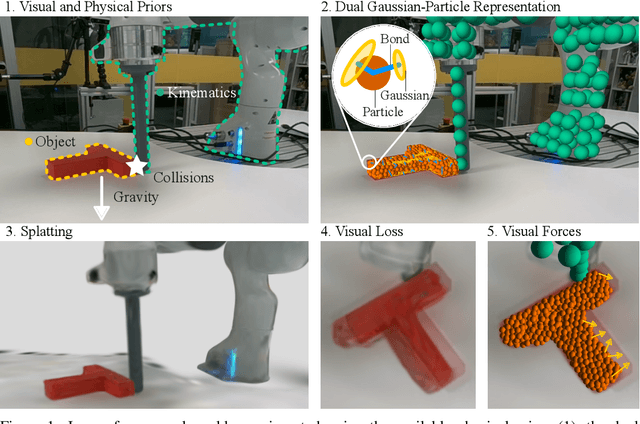



Abstract:For robots to robustly understand and interact with the physical world, it is highly beneficial to have a comprehensive representation - modelling geometry, physics, and visual observations - that informs perception, planning, and control algorithms. We propose a novel dual Gaussian-Particle representation that models the physical world while (i) enabling predictive simulation of future states and (ii) allowing online correction from visual observations in a dynamic world. Our representation comprises particles that capture the geometrical aspect of objects in the world and can be used alongside a particle-based physics system to anticipate physically plausible future states. Attached to these particles are 3D Gaussians that render images from any viewpoint through a splatting process thus capturing the visual state. By comparing the predicted and observed images, our approach generates visual forces that correct the particle positions while respecting known physical constraints. By integrating predictive physical modelling with continuous visually-derived corrections, our unified representation reasons about the present and future while synchronizing with reality. Our system runs in realtime at 30Hz using only 3 cameras. We validate our approach on 2D and 3D tracking tasks as well as photometric reconstruction quality. Videos are found at https://embodied-gaussians.github.io/.
RoboHop: Segment-based Topological Map Representation for Open-World Visual Navigation
May 09, 2024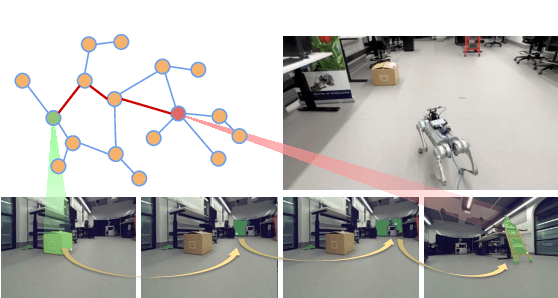
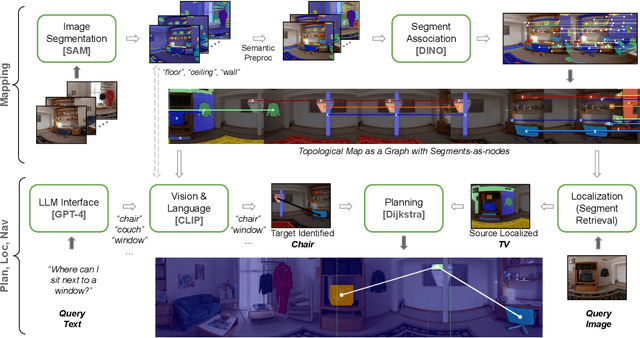
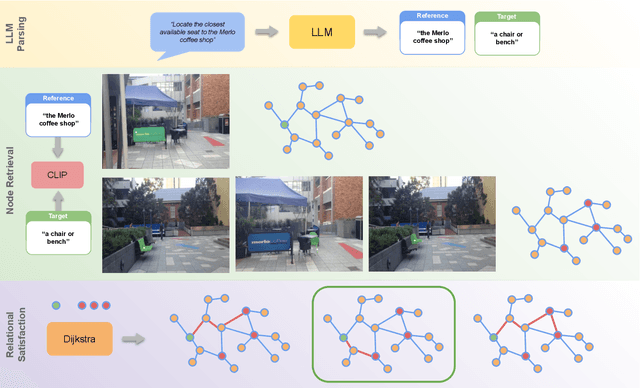
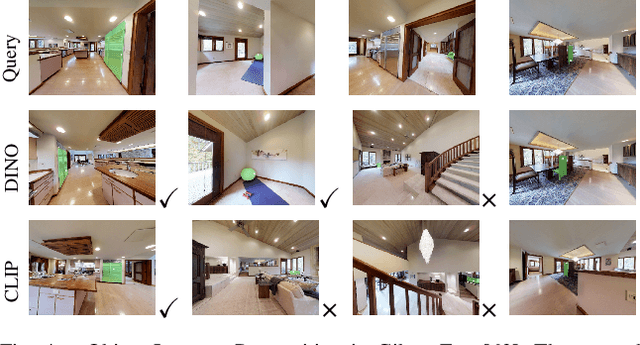
Abstract:Mapping is crucial for spatial reasoning, planning and robot navigation. Existing approaches range from metric, which require precise geometry-based optimization, to purely topological, where image-as-node based graphs lack explicit object-level reasoning and interconnectivity. In this paper, we propose a novel topological representation of an environment based on "image segments", which are semantically meaningful and open-vocabulary queryable, conferring several advantages over previous works based on pixel-level features. Unlike 3D scene graphs, we create a purely topological graph with segments as nodes, where edges are formed by a) associating segment-level descriptors between pairs of consecutive images and b) connecting neighboring segments within an image using their pixel centroids. This unveils a "continuous sense of a place", defined by inter-image persistence of segments along with their intra-image neighbours. It further enables us to represent and update segment-level descriptors through neighborhood aggregation using graph convolution layers, which improves robot localization based on segment-level retrieval. Using real-world data, we show how our proposed map representation can be used to i) generate navigation plans in the form of "hops over segments" and ii) search for target objects using natural language queries describing spatial relations of objects. Furthermore, we quantitatively analyze data association at the segment level, which underpins inter-image connectivity during mapping and segment-level localization when revisiting the same place. Finally, we show preliminary trials on segment-level `hopping' based zero-shot real-world navigation. Project page with supplementary details: oravus.github.io/RoboHop/
 Add to Chrome
Add to Chrome Add to Firefox
Add to Firefox Add to Edge
Add to Edge